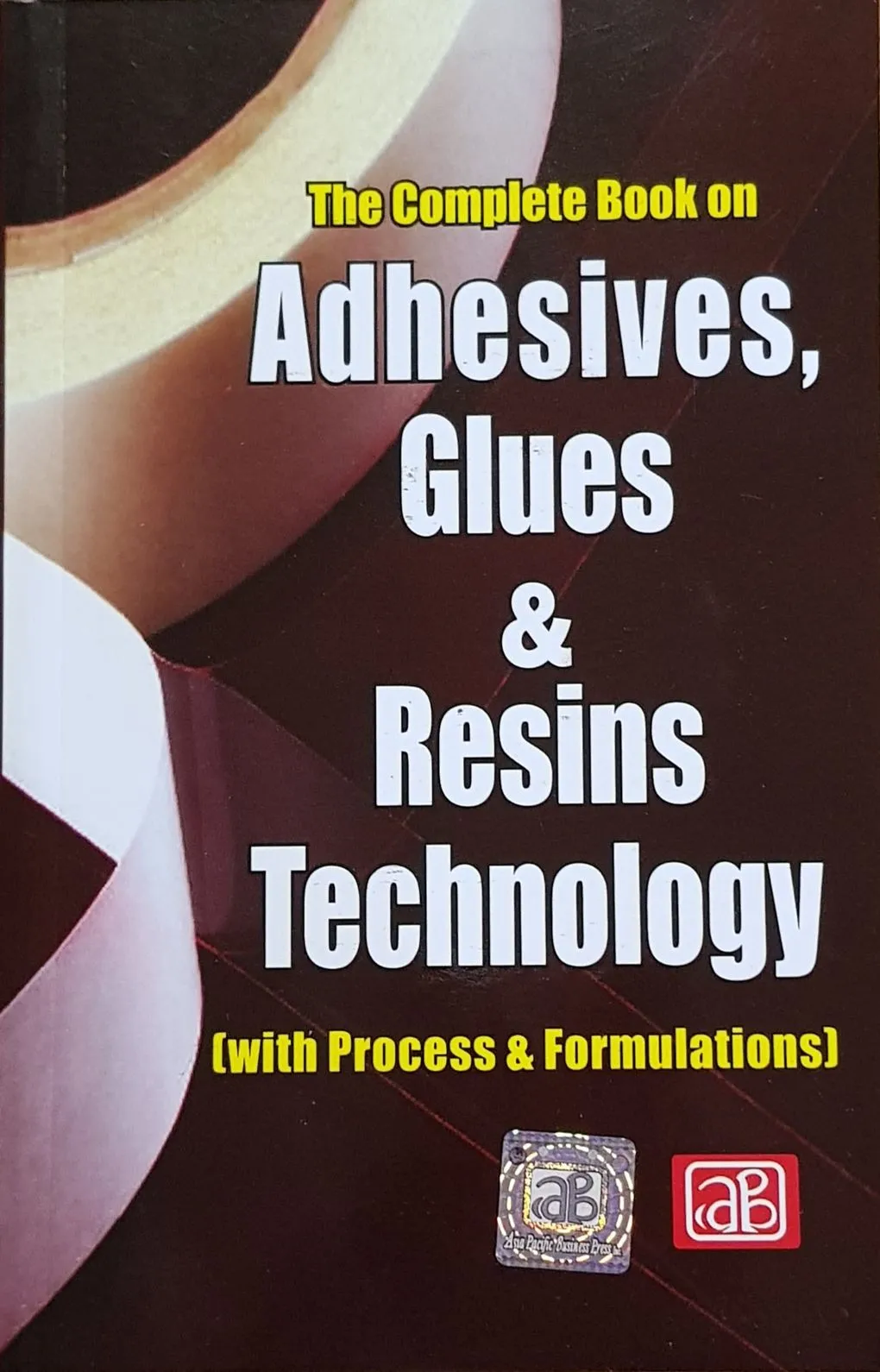An adhesive is a material used for holding two surfaces together. In the service condition that way adhesives can be called as “Social” as they unite individual parts creating a whole. A useful way to classify adhesives is by the way they react chemically after they have been applied to the surfaces to be joined. There is a huge range of adhesives, and one appropriate for the materials being joined must be chosen. Gums and resins are polymeric compounds and manufactured by synthetic routes. Gums and resins largely used in water or other solvent soluble form for providing special properties to some formulations. More than 95% of total adhesive used worldwide are based on synthetic resins. Gums and resins have wide industrial applications. They are used in manufacture of lacquers, printing inks, varnishes, paints, textiles, cosmetics, food and other industries.
Increase in disposable income levels, rising GDP and booming retail markets are propelling growth in packaging and flexible packaging industry. Growth of disposable products is expected to increase, which leads to increase in consumption of adhesives in packaging industry. The global value of adhesive resins market is estimated to be $11,339.66 million and is projected to grow at a CAGR of about 4.88% in coming years. Rapid urbanization coupled with growing infrastructure and real estate construction projects is projected to further fuel demand for adhesives in India.
This handbook covers photographs of plant & machinery with supplier’s contact details and manufacturing aspects of various adhesives, glues & resins. The major contents of the book are glues of animal origin, fish glues, animal glues, casein glues & adhesives, blood albumen glues, amino resin adhesives, cyanoacrylate adhesives, epoxy resin adhesives, phenolic resin adhesives, polychloroprene resin adhesives, polysulfide sealants & adhesives, resorcinolic adhesives, furan resin adhesives, lignin adhesives, polyamide adhesives, rosin adhesive, tannin adhesives, terpene based adhesives, starch adhesives, acrylic adhesives and sealants, pressure sensitive adhesives, hot melt adhesives, alkyd resins, acrylic modified alkyd resins, alkyd –amino combinations based on neem oil, amino resins, carbohydrate modified phenol- formaldehyde resins, epoxy resins etc.
It will be a standard reference book for professionals, entrepreneurs, those studying and researching in this important area and others interested in the field of adhesives, glues & resins technology.

The Complete Book on Adhesives, Glues & Resins Technology (with Process & Formulations) 2nd Revised Edition
ADHESIVES
1. Glues of Animal Origin
Properties
Methods of Manufacture
Commercial Grades and Specifications
Methods of Analysis
Sampling
Procedure
Identification
Physical Measurements
Determination of Other Constituents
2. Fish Glues
Introduction
Manufacturing Process
Properties
Applications & Formulations
Rubber-to-Steel
Strawboard-to-Steel
Rubber-or Cork-to-Plywood
Paper-to-Steel
Straight Line Gluing
3. Animal Glues
Introduction
Chemical Composition
Manufacture of Animal Glues
Properties
Liquid Animal Glues
Formulation & Applications
Methods of Application
4. Casein Glues and Adhesives
Introduction
Properties
Casein Blend Glues
Lime free Casein Adhesives
Applications
Casein Adhesives for Bonding Paper
Casein Adhesive for Binding Dissimilar Materials
5. Blood Albumen Glues
Introduction
Solubility Categories
Properties
Blood-Soybean Flour Combinations
Mold Resistance
Application
6. Amino Resin Adhesives
Introduction
Manufacturing Technology
Urea Adhesive for Plywood
Urea Adhesive for Particle Board
Spray Dried Melamine-formaldehyde Resins
Foundry Resin
Aniline-Formaldehyde Resin
Ø Represents benzene ring
Sulfonamide-Formaldehyde Resins
Applications
Adhesives for Hardwood Plywood
Sand Core Binder
Water Proof Corrugated Board
Compounding and Formulation
7. Cyanoacrylate Adhesives
Introduction
Bonding with Cyanoacrylates
Adhesive Properties
Applications
8. Epoxy Resin Adhesives
Introduction
Chemistry
Epoxy Novolac Resins
Flexible Epoxy Resins
Epoxidized Olefins
Speciality Epoxy Resins & Derivatives
Epoxy Esters of Rosin
Epoxy Esters of Styrenated Rosin
Epoxy Esters of Disproportionated Rosin
Epoxy Novolac Esters
Epoxy Ester of Maleopimaric Acid
Compounding
Curing Agents
Diluents
Modifiers
Flexibilizers
Fillers
Accelerators
Speciality Additives
Manufacture of Adhesives
9. Phenolic Resin Adhesives
Introduction
Resole resin
Novalac Resins
Manufacture
Applications and Formulations
Contact Adhesives
Adhesive Compounding
Nitrile/Phenolic Contact Adhesives
Structural Adhesives
Vinyl/Phenolic
Epoxy/Phenolic
Hot Melt Adhesives
Hot Melt Vinyl Film to Wood Laminating Adhesives
Pressure Sensitive Adhesives (PSA)
10. Polychloroprene Resin Adhesives
Introduction
Types of Polychloroprene
Applications and Formulations
Applications
11. Polyester Resin Adhesives
Introduction
Linear Polycarbonates
Polymerized Oils
Alkyd Resins
Unsaturated Polyester Adhesives
Adhesives for Flexible Printed Circuit
Allyl Ester Adhesives
12. Polyethyleneimine in Adhesives
Introduction
Applications
General Adhesives
Tie Coat Adhesives
13. Polysulfide Sealants and Adhesives
Introduction
Polysulfide Sealants
Chemistry
Compounding
Curing Agent
Retarder
Reinforcement
Adhesion Additives
Primers
Improved Heat Resistance
Applications
Adhesives from Polysulfide Liquid Polymer
Epoxy Resin Reactions
14. Resorcinolic Adhesives
Introduction
Resorcinol-Phenol Formaldehyde Resins
Modified Resorcinol Resins
Aspects of Adhesion Mechanism
Formulation of Glue Mixtures
Laminating
15. Ethylene Copolymer Hot Melt Adhesives
Introduction
Crystallinity
Compatibility
Pressure Sensitive Tack
Hot Melt Adhesive Formulating
Book Binding Adhesives
Carton and Case Sealing Adhesives
Carpet Application
Shoe Adhesives
Pressure Sensitive Adhesives (PSA)
Furniture Adhesives
16. Furan Resin Adhesives
Introduction
17. Isocyanate Adhesives
Introduction
Advantages of Isocyanate Adhesives
Disadvantages of Isocyanates
Applications
Types and uses of Isocyanate based Adhesive System
18. Lignin Adhesives
Introduction
Formulations
19. Polyamide Adhesives
Introduction
Class I: Thermoset Adhesives Containing Liquid
Polyamide Curing Adhesives
Class II: Nylon-Epoxy Resins
Class III: Thermoplastic Hot Melt Polyamide Adhesives
Class IV: Thermoplastic-Thermoset Adhesives
20. Polyimide Adhesives
Introduction
Adhesive and Bonding Technology
Foam System
21. Rosin Adhesives
Introduction
Applications
Formulations
Solvent Adhesives
Emulsion Adhesives
Hot Melt Adhesives
Methods of manufacture
22. Silicone Adhesives and Sealants
Introduction
Chemistry
Oxime silane
Properties
Rheological Characteristics
Thermal Stability
Weathering Characteristics
Adhesion Characteristics
Applications
Industrial
Construction
23. Tannin Adhesives
Introduction
Formulation
24. Terpene Based Adhesives
Introduction
Chemistry
Beta-pinene resins
Dipentene resins
Alpha-pinene resins
Physical characteristics of resins
Pressure sensitive adhesives
Hot melt adhesives
Analytical methods
Commercial resins and their uses
Commercial production
Applications in pressure sensitive adhesives
Applications in hot melt adhesives
25. Starch Adhesives
Introduction
Unmodified Starches
High Strength Adhesive
Cheap Diluted Adhesive
Non-weather Proof Corrugated Board Adhesive
Water Resistant Corrugated Paper Box Adhesive
Final Mixture
Acid Modified or Thin Boiling Starch Adhesive
Oxidised Starch Adhesives
Dextrin Based Adhesives
Properties
26. Acrylic Adhesives and Sealants
Polymerization
Solution Polymerization
Properties of the product
Emulsion polymerization
Properties of the dispersion
Properties
Formulations and Applications
Adhesives to paper coated with PVDC
Delayed tack adhesive
Adhesives for Laminating
Laminating Plasticized PVC film to textiles
Laminating PVC film to particle board
Laminating plasticized PVC film to split leather
High temperature &pressure lamination
Flocking Adhesives
Building Adhesives
Adhesives for plasticized PVC floor tiles
Adhesives for ceramic tiles
Pressure-Sensitive Adhesives
Flame Resistant & Pressure Sensitive Adhesive
Acrylic Sealants
Aqueous Acrylic Sealants
Solvent-Based Acrylic Sealants
27. Pressure Sensitive Adhesives
Adhesive Strip for Antomotive Trim
Eva-Trialkyl Cyanurate Copolymer Adhesive
Carboxylate Polymer Based Adhesives
Fumaric Diester Vinyl Acetate Polymer
28. Hot melt Adhesives
Introduction
Advantages
Disadvantage
Formulations
Ethylene-vinyl Acetate
Amorphous polypropylene and Petroleum Resin
Isopropenyltoluene Copolymers as Tackifiers
Chlorinated Polyphenyl, Chlorinated
Polyisoprene and Nitroso Compound
Carpet Backing Formulation
Other Polyolefin Compositions
Amorphous Polyolefin and Styrene Butadiene
Block Copolymers
a-Methylstyrene Tert Butyl Styreneolefin terpolymers
Alkoxystyrene-Acrylonitrile, Copolymers
Boric Acid as Viscosity Stabiliser in Ethylene-
Propylene Adhesives
Thermoplastic Polymer and Chelate of Aminoacetic
Acid
Coal Tar Pitch and Ethylene-Acrylic-Acid Copolymer
Water-Moistenable Vinyl Pyrrolidone-Vinylacetate
Product
RESINS
1. Alkyd Resins
Introduction
Classification
Synthesis
Etherification
Addition reactions of unsaturated monobasic
fatty acids
Addition reactions with other unsaturated alkyd
ingredients
Reactions during coating formation with drying
alkyds
Reactions during coating formation in alkyd blends
Raw materials
Manufacture
Health and Safety
Quality Control and Specifications
Analysis
Calculations
Uses
Use of Alkyds in Trade-Sales Finishes
Methods of Analysis
Determination of Composition
Chemical Methods
Determination of Properties and Impurities
2. Acrylic Modified Alkyd Resins
Traffic paints
Industrial applications
Conclusion
3. Alkyd-Amino Combinations Based on Neem Oil
Aim of present investigation
Uses of oils in surface coatings
Neem oil
Alkyd resins
Amino resins
Experiments & Results
Preparation of alkyd resin
Alkyd resin preparation
Preparation of amino resin
Testing of performances of resin samples
Discussion
Analysis of neem oil
Preparation of alkyd from neem oil
Preparation of urea formaldehyde resin
Preparation of thiourea formaldehyde resin
Preparation of various samples (mixtures)
Performances of various resin samples
Scratch hardness
Conclusion
4. Amino Resins
Introduction
Raw materials
Chemistry of resin formation
Typical resin formulations and techniques
Urea formaldehyde resins
High solids urea-formaldehyde adhesive resin
Protective coating resin with high mineral spirits
tolerance
Methylated urea formaldehyde textile resins
Urea-formaldehyde particle board adhesive
Melamine-formaldehyde resins
Butylated melamine protective coating resin
Chlorine resistant melamine resin
Trimethoxymethyl melamine
Hexamethoxymethyl melamine
Melamine resin molding powder
Melamine resin acid colloid
Control of the extent of the reaction
Free formaldehyde estimation
Viscosity tests
Solubility tests
Cure tests
Urea versus melamine resins
Package stability
Competitive product analysis
Chemical modification for water soluble products
Chemical modification for oil soluble products
Ethyleneurea
Methylated uron textile resins
Uron resins
Glyoxal resins
Miscellaneous resins
Amino resins in the paper industry
Formulations for regular and HE colloids
Toxicity
Methods of Analysis
Competitive Product Analysis
5. Carbohydrate Modified Phenol-formaldehyde
Resins
Introduction
Research on Carbohydrate Modified Resins
Carbohydrate-Modified Base-Catalyzed PF resins
Bonding Veneer Panels
Bonding Flakeboard Panels
Carbohydrate-Modified PF Resins Cured at
Neutral Conditions
Bonding Veneer Panels
Color of Bondline
Conclusions
6. Epoxy Resins
Introduction
Synthesis of Resin Intermediates
Cycloaliphatic epoxies
Epoxidized polyolefins
Epoxidised oils and fatty acid esters
Aliphatic-cycloaliphatic glycidyl type resins
Epoxy novolac resins
Resins from phenols other than bisphenol A
Resins from aliphatic polyols
Resins from long chain acids
Fluorinated epoxy resins
Epoxy resins from methylepichlorohydrin
Miscellaneous epoxy resins
Epoxy esters
Water borne epoxy resins and derivatives
Diluents and modifiers
Epoxide reactions and curing mechanisms
Curing of epoxy esters
7. Photographs of Plant & Machinery with Supplier’s Contact Details
Customer Reviews
No reviews yet. Be the first to write one!

